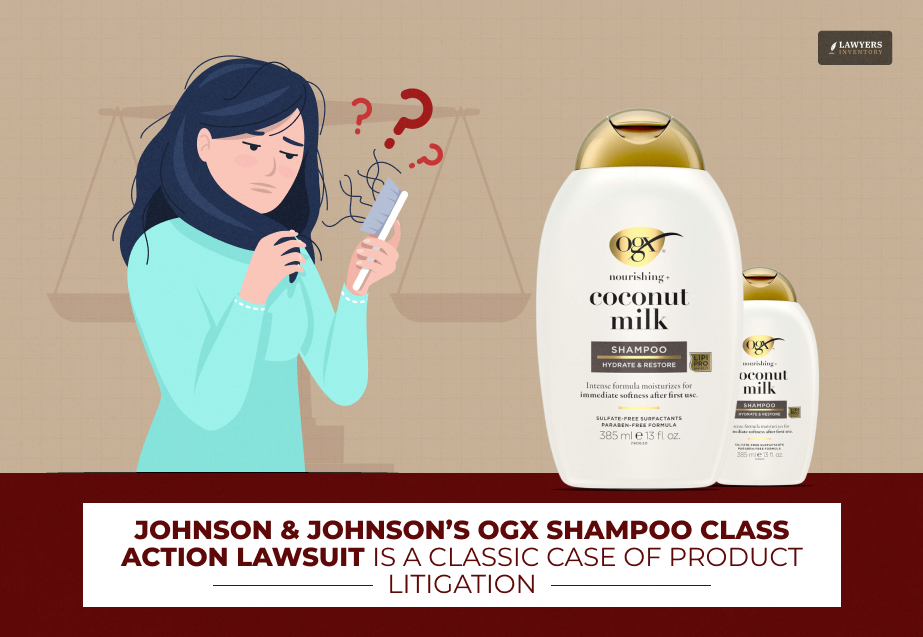
When we talk about beauty, we know the ingredients mean everything in a product. But what happens when there is a fault in the ingredients of a product? This is exactly what happened with Johnson & Johnson’s OGX lawsuit.
It all started in 2021 when plaintiff Larissa Whipple alleged that the company misrepresented the products as nourishing while concealing their harmful effects.
But how much of this is true? Did the shampoo really cause hair fall? Or was it just a one-person thing? In today’s article, this is exactly what I will be talking about.
If you have been following the updates regarding the Johnson and Johnson lawsuit and want to know about this product line, you have come to the right place.
In this article, I will talk about the following things:
- What is the OGX lawsuit about?
- What are the allegations in the lawsuit?
- How did OGX respond to the lawsuit?
- What’s the impact of this lawsuit?
So, if these are some of the things that you want to know, keep on reading this blog till the end…
Background of the OGX Lawsuit
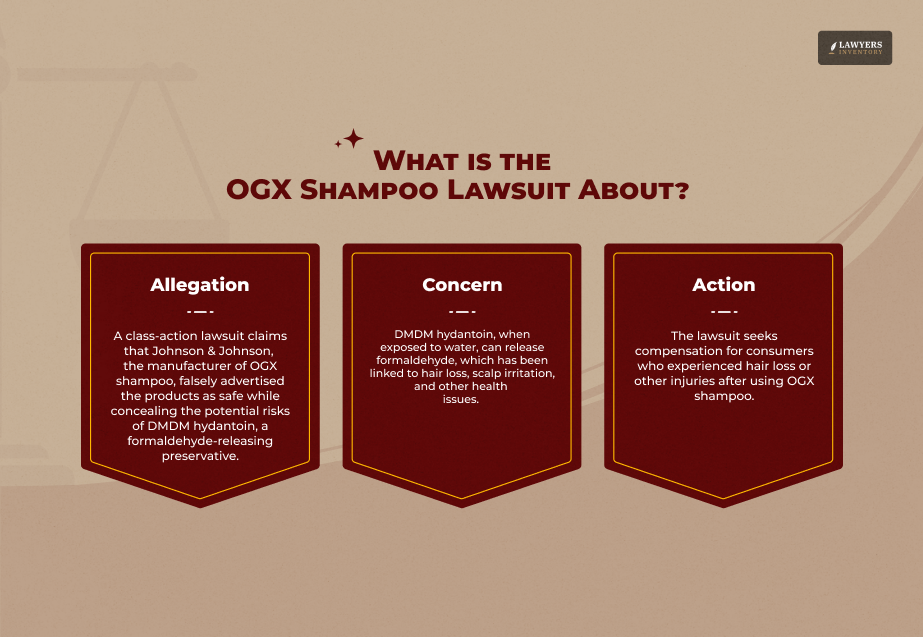
In recent years, Johnson & Johnson’s OGX shampoo line has found itself at the center of a class-action lawsuit that has raised significant concerns among consumers.
The lawsuit, initiated by plaintiff Larissa Whipple, alleges that certain OGX products cause hair loss and scalp irritation due to harmful ingredients.
Specifically, the focus is on DMDM hydantoin, a preservative used in many OGX shampoos and conditioners. Experts link this ingredient to the release of formaldehyde (a carcinogen) when it comes into contact with water. For instance, the International Agency for Research on Cancer (IARC) classifies this as a carcinogen.
Whipple claims she purchased OGX products based on their advertised benefits, which promised to nourish and repair hair.
However, she argues that the company failed to disclose the potential dangers associated with these products.
The lawsuit, dismissed in 2022, seeks to represent all consumers who have purchased OGX shampoos and conditioners, highlighting a broader issue of consumer safety and transparency in product marketing.
The OGC lawsuit against the products states that the company has used DMDM hydantoin as a preservative in the J&J products to save them from molding for over a decade.
However, the plaintiff mentions that the usage of this ingredient is an unnecessary risk. It’s something that the company can easily avoid, considering there are several safer alternatives.
What Are The Allegations In The OGX Lawsuit?
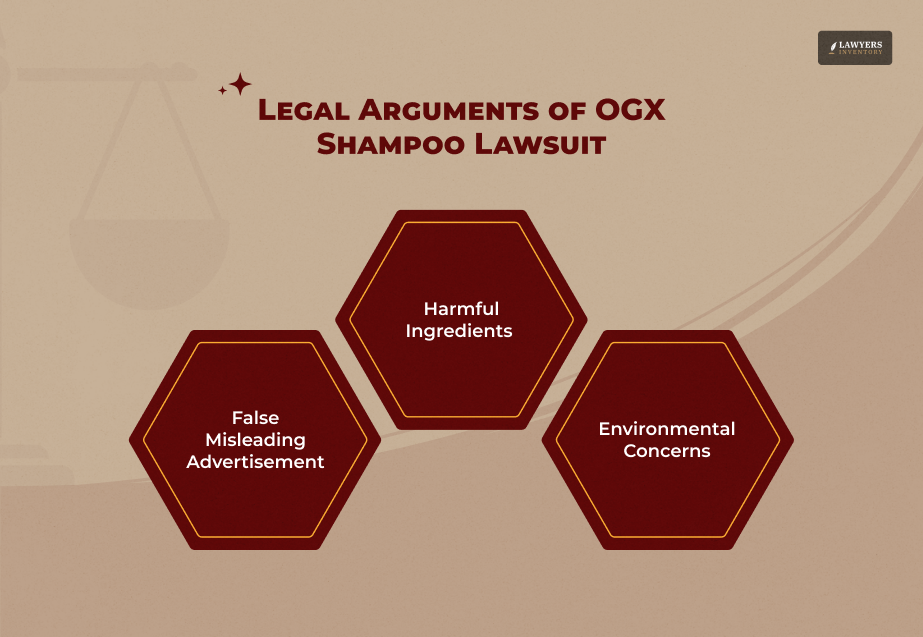
Like in the case of any particular lawsuit, the OGX lawsuit also had several legal arguments that the plaintiff has put forward. These were the basis of the cases against J&J’s shampoo.
“Through its labeling and an extensive marketing campaign, including through its website and online advertisements, Johnson & Johnson made a number of affirmative misrepresentations: that the Products contain special formulas (e.g. “Argan Oil, Biotin and collagen, Coconut Oil, Pomegranate”) intended to nourish and revive damage or dry hair, add softness and shine, and prevent frizzing and tangling; and that the Products “deeply nourish,” “gently cleanse,” and “repair hair.”
This is something that the lawsuit mentions. But is that all? Or are there other allegations that you need to know about before using the product? I have you covered in that regard as well.
Here are the three main legal arguments of the lawsuit:
False Misleading Advertisement
One of the primary legal arguments in the lawsuit revolves around false advertising. The plaintiff contends that Johnson & Johnson made misleading claims about the benefits of its OGX products. Sounds similar to the popular ZYN lawsuit, right?
Advertisements suggested that these shampoos would “deeply nourish,” “gently cleanse,” and “repair” damaged hair. However, the lawsuit asserts that these claims are deceptive because they do not inform consumers about the risks associated with DMDM hydantoin.
This misrepresentation has led many customers to believe they were using safe and effective products while exposing them to potential harm.
Harmful Ingredients
Another critical point in the lawsuit is the presence of harmful ingredients in OGX products. Plaintiff has highlighted DMDM hydantoin as a significant concern because it is a formaldehyde donor.
Formaldehyde has been classified as a human carcinogen by various health organizations, raising alarms about its safety in consumer products.
The lawsuit argues that Johnson & Johnson has known about these risks. Yet, they continued to use DMDM hydantoin in their formulations without adequately warning consumers.
Furthermore, the complaint suggests that safer alternatives are available but were ignored by the company in favor of maintaining their product formulations.
Environmental Concerns
Lastly, the lawsuit touches upon environmental concerns related to the use of certain chemicals in personal care products.
The argument posits that these ingredients pose health risks to consumers. Additionally, they have broader implications for environmental safety.
As more people become aware of the potential dangers associated with chemical preservatives like DMDM hydantoin, there is growing pressure on companies to adopt cleaner and safer formulations.
The failure to do so not only affects consumer trust but also raises ethical questions about corporate responsibility in protecting both public health and the environment.
Johnson & Johnson’s Response to OGX Lawsuit Claims
In 2012, Johnson & Johnson declared they would no longer use DMDM hydantoin in their products by 2015.
DMDM hydantoin “do not meet our safety and care standards,” according to the company’s safety and care commitment website.
However, it later claims that the preservative is used “in a small number” of its products when other preservatives are “incompatible” with other substances.
After the OGX Lawsuit broke out, people were eager to get an update or a response from the company. In an interview with Prevention, this is what Johnson and Johnson mentioned:
“We stand behind the performance and rigorous testing of our products. We carefully select our ingredients and include a list on the product’s label. At OGX, we are constantly evolving our formulas to improve hair care results and haven’t launched any new products with DMDM hydantoin in the last several years.”
Internet is Divided: Was OGX Shampoo Class Action Lawsuit “Baseless?”
I was trying to do my research about the OGX lawsuit before writing this blog. And quite naturally, I went to Reddit to see some of the real consumers’ opinions about the shampoo. And I was shocked to see how people are divided.
In a deleted Reddit thread, one user wrote that the “concerns about DMDMH were completely ridiculous, as our bodies produce formaldehyde naturally and are excellent at removing it even if there was any chance of absorbing any significant amount through your skin.”
The user continued to mention the fact that this lawsuit was filed in 2021 during peak COVID 19 years. “Any product that isn’t right for your scalp might result in increased hair fall but that doesn’t mean the product in general is unsafe. Further, the uptick in autoimmune issues caused by COVID… have also resulted in a lot of people experiencing hair loss and just not linking it to the fact that they had COVID.”
“If OGX worked for you, go back to it,” they added.
Impact of OGX Lawsuit: Understanding Consumer Rights
The ongoing class-action lawsuit against Johnson & Johnson’s OGX shampoo line has significant implications for consumer rights.
At its core, this lawsuit highlights the importance of transparency and safety in product marketing. Consumers have the right to know what is in the products they use daily, especially when it comes to personal care items like shampoos and conditioners.
One of the main issues raised in the lawsuit is the alleged misleading advertising surrounding OGX products. Many consumers purchased these shampoos, believing they were safe and beneficial for their hair.
However, the claims made by Johnson & Johnson about the nourishing properties of these products are now under scrutiny. This situation serves as a reminder that consumers should be vigilant and informed about the ingredients in their beauty products.
Moreover, this lawsuit empowers consumers to hold companies accountable for their claims. When large corporations like Johnson & Johnson face legal challenges, it sends a message that misleading advertising and harmful ingredients will not be tolerated.
Consumers have a voice, and collective action can significantly change how products are formulated and marketed.
Additionally, this case raises awareness about the potential health risks associated with certain chemicals commonly found in beauty products.
As more people become aware of ingredients like DMDM hydantoin, which is linked to hair loss, there is a growing demand for safer alternatives. This shift could lead to more stringent regulations regarding ingredient safety and labeling, ultimately benefiting consumers.
Legal Impact of OGX Lawsuit on Beauty Industry and Marketing
The OGX lawsuit is one the legal consequences reach to the extent of creating a new beauty industry which is quite different from the existing one, as the whole industry is the beauty trade with Johnson & Johnson companies.
Consumers’ growing awareness of their rights and potential dangers of certain ingredients could lead to a complete change of the way companies market and the products they formulate.
Also, the result of this lawsuit may become a cause for setting up stringent rules for advertising in the beauty sector.
In case the courts determine that J&J intentionally misled consumers, this could be what we call a beacon light in the realm of false advertisement disputes. Hence, the rest of the companies will be prudent in doing so, and to engage in marketing that is less risky from the legal point of view, they may generally re-orient their business strategies centralized around the compliance aspect.
Also, more consumer activists for beauty products safety is another potential outcome that this controversy may generate. When the masses are sufficiently enlightened about their rights, they may expect government agencies that regulate cosmetic safety to implement more rigorous regulations.
Such a bottom-up movement may indeed reshape the whole paradigm of how beauty products receive regulatory approval and transform the process into one that prioritizes consumer health.
Read Also:
- Sierra Mist Lawsuit: Did PepsiCo Really Clash with Influencer Over Identity Theft?
- University of Metaphysical Sciences Lawsuit and the Saga of Predatory Litigation
- 72 Sold Reviews Consumer Reports After Recent Lawsuit

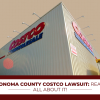




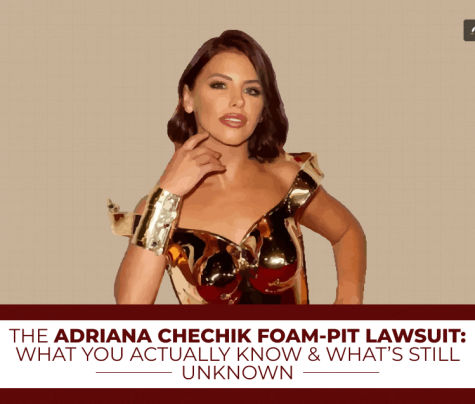




0 Reply
No comments yet.